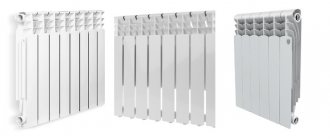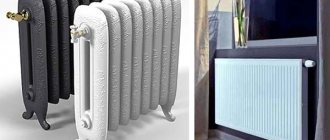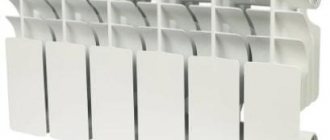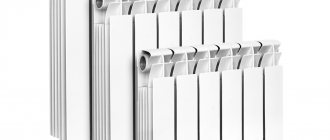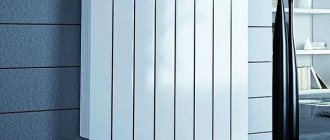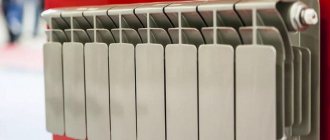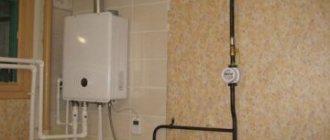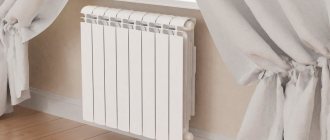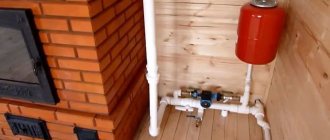The heating engineering market is filled with a wide range of bimetallic and aluminum radiators. The models have a beautiful appearance, are compact and light in weight. Both types of heating devices fit equally harmoniously into any, most sophisticated, interior of rooms. But a rhetorical question arises, which radiators are better - bimetallic or aluminum?
In the competitive struggle, manufacturers of heating radiators are making great efforts to create more and more advanced types. They are striving to create bimetallic and aluminum batteries that most effectively transfer heat from the coolant liquid to the interior space of the room.
Comparative analysis of bimetallic and aluminum radiators
Despite all the external similarities between the two types of products, there is quite a big difference regarding many features and characteristics. Often, the consumer is faced with the problem of determining which heating radiators are better - aluminum or bimetallic. Each of these two types of heating batteries has its own pros and cons.
In this article we strive to convey to the consumer all the advantages and disadvantages of these types of heating radiators. By comparing their quality characteristics with the local conditions of their own or centralized heating system, it will be easier for the consumer to make a choice in favor of one model or another.
Aluminum radiators
Models made of non-ferrous metal appeared on the heating engineering market relatively recently. In fact, the products are not made of aluminum, but of its alloy - silumin, where 12 - 14% silicon and a small amount of various metals are added to the base. Compared to aluminum, silumin has greater strength and wear resistance.
DO NOT BUY Radiators Until You See THIS!!!
The main advantage of silumin heating panels is their complete immunity to corrosion. The products are very popular among owners of both small houses and huge mansions. To show all the advantages of silumin heating devices, you need to consider the range of a number of the following characteristics.
Manufacturing technology
Products from silumin are produced by extrusion. To do this, a mold is made for filling (opka) with molten metal.
A feature of the process is that the mold is filled by pressing the molten alloy under pressure through a hole in the flask. This action achieves a high-density array of the device, which completely eliminates the appearance of cavities in the metal.
Design Features
There are two types of manufacturing - the creation of monolithic panels and prefabricated sections. In both cases, each section consists of a standard set of elements. These are two collectors (horizontal upper and lower collectors) with a diameter of 25 mm. They are connected by vertical shafts of oval cross-section with ebbs in the form of vertical convection fins on the sides and front of the radiator.
Section structure:
- Radiator housing.
- Polymer coating.
- Front fins.
- Horizontal channel with thread.
- Lateral ribbing.
Unlike monolithic batteries, prefabricated products consist of sections connected to each other by steel nipples with multidirectional threads and gaskets. Aluminum heating devices of standard assembly consist of 3, 4, 5, 6, 8, 9, 10, 12, 15, 17 and 21 sections. The height of the ribs is 200, 250, 300, 350 and 500 mm.
Prefabricated structures allow the homeowner to select the number of sections for each model. This plays an important role in determining which batteries are better for an apartment, aluminum or bimetallic.
Difficulty of installation
All silumin models are mounted radiators. They are installed on brackets fixed to the walls. Due to the lightness of silumin, powerful supports are not required for mounting batteries. To install heating devices, you may need a hammer drill and dowels. If plastic pipes are connected to the radiator, then you will need a welding machine and plastic adapters.
The installation process does not cause any particular difficulties. During installation, a number of conditions must be met. This is the horizontality of its upper surface, the gap between the wall and the back of the battery should be at least 4 cm, and the gap between the top of the device and the bottom of the window sill should be 5 - 7 cm.
In addition to ready-made panels, batteries are assembled by twisting sections using nipples with gaskets directly at the installation site. The operation is so simple that it is accessible to anyone who wants to independently assemble a sectional structure of the required size.
Working temperature
Aluminum radiators can withstand hot water at its maximum temperature - 1000 C. In autonomous heating systems of private houses, water is replaced with a synthetic liquid coolant with a maximum heating temperature of about 1300 C, which silumin can withstand.
To eliminate crisis excesses of the temperature threshold, a thermostat is built into the heating system. Heating panels are also equipped with thermal heads, which prevent overheating of the heating panels.
Thermostats come with manual and automatic settings, and the most expensive devices can be configured online with a smartphone through the Smart Home system.
Operating pressure
Radiators: aluminum or bimetal? “Never bet!” And other myths.
The main material for the manufacture of modern aluminum radiators is silumin, which, due to its fragility, cannot withstand pressure surges in centralized heating systems. The devices are designed for a limit of 16 atmospheres. Some models can withstand 20 atm.
Peak pressure in central hydraulic systems can reach 40 atmospheres, not to mention water hammer, where this figure can be even higher. For this reason, it becomes clear that it is better to install bimetallic radiators in an apartment, and aluminum radiators in a private house, where there are no such negative phenomena.
For what premises?
There are no special restrictions in this regard. Silumin perfectly withstands high humidity conditions. The only limitation is that radiators are not installed in rooms where there is a risk of freezing temperatures. When the coolant freezes, the battery simply ruptures.
Heat dissipation
In terms of heat transfer, aluminum products have no equal. One section of a silumin battery is capable of delivering up to 200 W of thermal energy.
Half of it is emitted by the device, and the second part enters the room by convection. The battery surface warms up completely within a few minutes.
Reliability and service life
Silumin, from which heating radiators are made, is a rather fragile material. They should be placed in places where there is the least risk of accidental mechanical impacts.
According to the manufacturers, the devices are designed for a service life of 10–15 years.
This is the minimum “experience” under the most unfavorable operating conditions. If the batteries are properly installed, filled with clean coolant and regularly subjected to preventive maintenance, then they can operate in trouble-free mode twice or even three times longer.
Interaction with coolant
The material is resistant to corrosion as long as it is in contact with clean water. Synthetic fillers can contain aggressive additives to non-ferrous metals. Hot water with contaminants is a common phenomenon inherent in centralized heating systems.
A coolant with high acidity can corrode silumin, which can cause destruction of the battery and flooding of the room. In autonomous heating systems, it is easier to control the cleanliness and inertness of the coolant by installing additional filters. This creates favorable operating conditions for heating radiators.
Price
If we compare prices for aluminum radiators and bimetallic analogues, then an objective comparison can only be made between branded devices.
An analysis of offers on the heating engineering market shows that anodized batteries are 10–15% cheaper than bimetals.
Positive properties of aluminum batteries
Aluminum radiators are light and durable, easy to transport and install. In addition, they also have a number of important advantages:
- small sizes (shorter in width compared to cast iron);
- very high level of heat transfer;
- operating pressure corresponding to the needs of modern heating systems;
- you can select a product with a certain number of sections according to the heated area;
- good heat transfer, which means efficiency;
- the ability to adjust the temperature using built-in thermostats;
- excellent aesthetic appearance.
The advantages of aluminum radiators over bimetallic ones are their lower price, which is very important for the consumer.
Advantages and disadvantages
Batteries made from silumin, along with positive characteristics, have a number of disadvantages. Both should be considered.
pros
The advantages of products of this type include the following:
- silumin, retains all the positive characteristics of aluminum, while imparting additional strength to the metal;
- high heat transfer. Almost instantaneous heating of the surface of the heating panel. In a few minutes the battery reaches maximum heating;
- the optimal dimensions of the products allow them to be compactly placed under the windows, without going beyond the width of the window sills;
- the sectional design of the batteries allows you to shape the dimensions of the heating panels in each individual case;
- affordable prices for non-ferrous metal batteries for the average consumer.
Minuses
The disadvantages of silumin products include the following:
- fragility of the metal, which is fraught with destruction due to pressure drops and water hammer in the heating system;
- along with rapid heating, the batteries also cool quickly, which negatively affects the heating of the entire room;
- during the summer season, the coolant cannot be drained from the system as there is a risk of internal corrosion;
- The risk of corrosion is much higher for simple aluminum products than for anodized models.
Bimetallic radiators
What is the difference between aluminum radiators and bimetallic ones and which ones are better?
At the end of the last century, the engineering idea of combining aluminum, as a good transmitter of thermal energy, with strong and reliable steel in one product, received its practical application in bimetal. With the invention of this type of heating devices, it was possible to relieve non-ferrous metal from direct contact with the coolant by finning the steel body of the radiator itself.
Due to their qualities, heating devices are able to withstand contaminated hot water in centralized heating systems. If you need to determine which heating radiators are best to choose for an apartment - aluminum or bimetallic, then it is better to choose the latter type of radiators.
Manufacturing technology
The process of manufacturing radiators from two metals consists of several stages. First, a body is created from steel tubes. The tubes are welded into a single manifold on an automated line, then they are crimped, threaded and purged. The steel section is placed in a mold (flask). Through a hole in the flask, a molten mass is fed under pressure, which is formed in the form of ribs.
The finished sections are sanded and painted in two times. First, the radiators are dipped into a container of paint under electrical voltage. During the process of anaphoresis, the paint penetrates deeply into the silumin, forming a durable layer over the entire surface of the battery. Finally, the sections are sprayed with an epoxy-polyester composition. After heat treatment, radiators acquire a finished appearance.
Design Features
A bimetallic radiator differs from an aluminum one in that the coolant is in contact only with steel and cannot aggressively influence the aluminum frame. Due to the steel collector, heating panels weigh much more than their aluminum counterparts. At the same time, bimetal is much stronger than silumin batteries.
Difficulty of installation
Unlike monolithic heating panels, bimetallic batteries are assembled from several sections. There can be from 3 or more than a dozen of them in one product. Batteries are assembled by twisting sections using nipples with double-sided threads and gaskets.
Both monolithic and sectional products are supported on brackets mounted into the walls. The installation rules are the same as for silumin batteries (see the chapter of the same name in the aluminum radiators section above).
Working temperature
If you decide which radiator to choose from the point of view of operating temperature, then the answer will be unequivocal in favor of bimetallic products.
The steel manifold can withstand heating temperatures of over 1000 C.
Practice shows that most boilers can bring the maximum heating temperature of the coolant liquid to 900 C. There are autonomous heating systems in private homes where water vapor is used as a coolant, which can heat up to 1300 C or more. In this case, the question of which batteries are better does not arise. In this regard, only cast iron can be an alternative to these radiators.
Operating pressure
As for the maximum operating pressure in heating radiators, bimetallic products remain the leaders. If we compare these acceptable parameters, then silumin radiators remain far behind bimetal.
As was said earlier in this article (see the item of the same name in the aluminum radiators section), the centralized heating system “suffers” from differences in operating pressure in the heating radiators of apartments in multi-storey buildings. There is also a risk of water hammer, where the peak pressure can reach 40 atm. Only bimetallic, steel and cast iron batteries are able to withstand these negative phenomena.
For what premises?
Just like aluminum devices, bimetal can be installed in rooms with high levels of humidity. Since water passes inside steel pipes, the batteries are insured against destruction if they freeze.
Steel is a fairly durable material and, due to its thickness (2 - 3 mm), can withstand in those rooms where there is a risk of freezing temperatures.
Heat dissipation
Compared to aluminum, bimetallic radiators are more inertial devices. They heat up more slowly and also cool down slowly. Aluminum products are characterized by high thermal conductivity, which averages 160 - 180 W/m2 of the silumin surface of the radiator.
We invite you to familiarize yourself with the Top 18 bimetallic heating radiators - a rating of the best models.
Therefore, in terms of heat transfer, the bimetal is inferior to aluminum. The fact is that the steel collector does not have time to take away as much heat from the coolant as silumin does. Based on various calculations carried out by branded manufacturers of heating appliances, the heat transfer of bimetal is 1.5 times less than that of aluminum appliances.
Reliability and service life
Bimetallic radiators are very popular among consumers due to their long service life (15 - 20 years). As a rule, manufacturers guarantee their trouble-free operation during this time.
Silumin, as the most fragile material, does not come into contact with the coolant, and the steel pipes of the collector successfully withstand peak pressure drops and the effects of aggressive impurities in hot water. With regular preventive maintenance of a centralized heating system, bimetallic batteries can last an unlimited number of years.
Interaction with coolant
Steel collectors of bimetallic radiators have anti-additive properties and do not contribute to the formation of deposits on their internal walls from contaminated coolant. Despite this, experts recommend flushing the heating system with cleaning agents if heat transfer deteriorates.
Of all types of heating radiators, only cast iron, steel and bimetallic ones can be used in steam heating systems, where the coolant temperature can reach 130 degrees or more.
Price
You can find a large number of offers for the sale of bimetallic sections. Despite the large difference in prices, it is possible to create an approximate average cost of bimetal based on certain characteristics.
So, for example, to heat a well-heated room, you will have to spend about 19 - 20 thousand rubles on the purchase of bimetallic heating devices.
How to distinguish
Externally, both types of batteries are very similar, so problems arise when choosing. Knowing how to visually distinguish an aluminum radiator from a bimetallic one, you can independently choose the appropriate model for your home or apartment. There are signs that allow you to quickly determine the type of equipment you need.
Section options Source otoplenie-expert.com
Pure aluminum batteries are lighter in weight than bimetal structures. Sections of the same size and shape will vary in weight. The steel core is 0.5 kg heavier than one-piece models.
How to choose a design Source yandex.ua
In order not to confuse structures made of different materials, professionals recommend inspecting the threads. In a bimetallic radiator, in areas where water passes through, the integrity of the structure is noticeable. A silvery layer of aluminum is visible on the gray surface of the steel pipe. There is a color transition between the two metals.
Understanding how to distinguish an aluminum radiator from a bimetallic one visually, you can determine the desired model by ear. If you knock on steel, the sound will be loud. The one-piece design produces a dull tone. The check is carried out with a wooden pencil, nail or plastic pen.
How not to make a mistake with the view Source pirco.ru
A magnet will help you find out the type of material. The internal steel filling attracts the device, but aluminum has no attraction. The device is brought closer to the center of the structure, where the metal pipe is located.
Advantages and disadvantages
Batteries made of two materials, steel and silumin, have both positive and negative properties.
An objective assessment of the pros and cons in this regard is especially important when it is necessary to determine in specific indoor conditions whether aluminum or bimetal is better.
pros
The advantages and benefits of bimetallic radiators include the following:
- long service life - 25 years;
- high threshold of maximum heating temperature - 130 degrees or more;
- resistance to pressure drops and water hammer up to 40 atmospheres;
- immunity to corrosion;
- the versatility of the design allows you to replace damaged sections or change their number in one battery.
Minuses
Along with their advantages, bimetallic radiators “suffer” from some disadvantages - these are:
- when draining the coolant in the off-season, there is a risk of corrosion of the inner surface of the steel collector;
- the small bore diameter of the collector pipes affects less heat transfer than that of aluminum devices;
- the price of bimetal is approximately 20 - 30% higher than the price of aluminum products.
Compliance with State Standards
For all heating systems and their elements there is a single register of State Standards, which they must comply with. Everything is taken into account:
- Quality and safety of production.
- Compliance with temperature conditions and pressure in pipes.
- What should be indicated in the data sheet of the finished product.
- Standards according to technical characteristics and permissible deviations from the norm.
If you want to buy bimetallic radiators, GOST will tell you what parameters they should have, and they must correspond to the indicators in the documentation for each product. If they do not match, it is better not to purchase such products.
Bimetallic radiators do not yet have analogues in quality and reliability among similar products. They can be installed in systems with the most unstable pressure and low-quality coolant. As for semi-bimetallic models, their cost is 20% lower than that of their full-fledged “brothers,” but they can only be installed in autonomous heating systems. The most expensive options for these devices are a combination of copper collectors with an aluminum body, but their heat transfer level is much higher.
When choosing a bimetallic radiator, you should carefully read not only its technical data sheet, but also the reputation of the manufacturer, and remember that these products cannot be cheap. This will prevent you from buying a fake.
